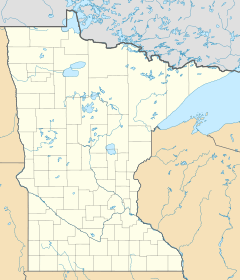Stump River facts for kids
Quick facts for kids Stump River |
|
|---|---|
|
Mouth of the
|
|
| Country | United States |
| State | Minnesota |
| County | Cook County |
| Physical characteristics | |
| Main source | 48°02′31″N 90°06′06″W / 48.0418312°N 90.1017573°W |
| River mouth | 48°01′29″N 89°58′57″W / 48.02472°N 89.98250°W |
The Stump River is a 14.2-mile-long (22.9 km) river in Minnesota, United States. It flows into the Pigeon River. This river is special because it runs through the beautiful Boundary Waters Canoe Area Wilderness. This wilderness is part of the larger Superior National Forest.
Contents
Exploring the Stump River
The Stump River is about 14.2 miles (22.9 kilometers) long. It is a smaller river, also called a tributary. This means it flows into a larger river, which in this case is the Pigeon River. The Pigeon River then flows into Lake Superior.
Where the River Flows
The Stump River starts in a wild area of Cook County, Minnesota. Its journey takes it through the amazing Boundary Waters Canoe Area Wilderness. This area is known for its many lakes, rivers, and forests.
Part of a Big Forest
The Boundary Waters Canoe Area Wilderness is a protected natural space. It is inside the Superior National Forest. This forest covers a huge area in northeastern Minnesota. It is a very important place for nature and wildlife.
Nature Around the Stump River
Rivers like the Stump River are important homes for many plants and animals. The water and the land around the river create a special habitat. This habitat supports a variety of living things.
Wildlife in the Area
You might find many different animals living near the Stump River. These could include moose, black bear, and white-tailed deer. Smaller animals like beaver, otter, and mink also live here. They use the river for food and shelter.
Birds and Fish
Many types of birds also visit or live near the river. You might see bald eagles soaring overhead or loons diving for fish. The river itself is home to various fish species. These fish are a food source for many other animals.
Plants and Trees
The forests around the Stump River are full of different trees. You might see pine trees, spruce trees, and birch trees. These trees provide shelter for animals and help keep the river water clean. Many smaller plants and wildflowers also grow along the riverbanks.
Protecting the River
The Stump River flows through a wilderness area. This means it is kept as natural as possible. People visit this area to enjoy nature, often by canoeing or hiking. Protecting rivers like the Stump River helps keep our planet healthy. It also makes sure these beautiful places are there for future generations to enjoy.


